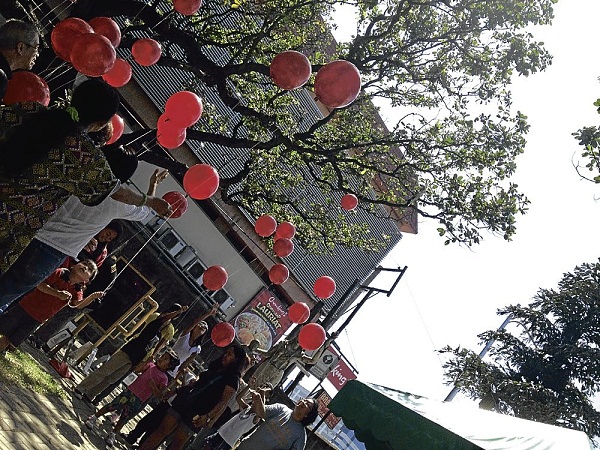Kin of ‘desaparecidos’ mark ‘Undas’ with hope, despair

FAMILIES of the disappeared release balloons on Friday at the Bantayog ng mga Desaparecido outside Redemptorist Church in Baclaran, Parañaque City, where they hold their own memorial for loved ones whose fates remain unknown. Photo by Jaymee Gamil
While most Filipinos fondly relived the memories of their dearly departed on All Saints’ Day and All Souls’ Day, families of desaparecidos remained in suspension, “swinging between hope and despair.”
This was how Nilda Sevilla, younger sister of missing human rights lawyer Hermon Lagman, described the pain she and other colleagues suffer over the unknown fates of loved ones who were “forcibly disappeared.” Another brother of hers, labor leader Filemon “Popoy” Lagman, was killed in 2001.
With no closure to mark and no graves to visit, members of the group FIND—for “Families of Victims of Involuntary Disappearance”—gathered instead at the Bantayog ng mga Desaparecido on the Redemptorist Church grounds in Baclaran, Parañaque City.
A mother-and-child sculpture— she holding up a torch and the child holding a photo to his chest—serves as the centerpiece of the Flame of Courage memorial shrine which was built in 1994.
Lagman’s name is just one of more than 500 etched on the slabs around the monument, which lists down persons who have disappeared in connection with armed conflicts and political upheavals from 1971 to 2003.
Article continues after this advertisementLagman, along with fellow activist lawyer Victor Reyes, has been reported missing since May 11, 1977. Their families believe they were abducted by government agents during the Marcos dictatorship.
Article continues after this advertisementFor Sevilla, the families of desaparecidos bear a “unique” kind of pain during the yearly remembrance of the dead. “Our feelings swing between hope and despair.”
‘’There’s always the hope. What if, by a miracle, they are still around? But after 35 years, and knowing the military culture, at the back of my mind, perhaps they even ordered my brother to dig his own grave,” said Sevilla, now a cochair of FIND.
“This is common among us. There’s hope, but there’s also the realization that our loved ones were probably tortured to death,” she said. Either way, “there is no closure.”
Sevilla said her family had chosen to remember Hermon by taking up his cause. “He was kind and truly had a heart for the masses. And what he did has become a family advocacy.”
FIND was established in 1985 and now counts over a thousand members nationwide. Though the group was convened during the martial law period, Sevilla said enforced disappearances continued well beyond the Marcos years.
Under the present administration alone, 12 cases of desaparecidos have been documented by FIND, she said.
The group is currently counting on the enactment the Anti-Enforced Disappearance Bill, “a human rights legislation” whose principal author is another brother of Sevilla’s, Albay Rep. Edcel Lagman. The bill is now awaiting President Aquino’s approval.
“It’s been hard for us to file cases since whenever we do, the cases are categorized only as serious illegal detention, kidnapping or murder. We’ve been lobbying since 1996 for a special law that will make involuntary disappearance a distinct crime (since) it has different elements,” she said.
For one, she said, enforced disappearances have that element of impunity, with suspects being agents of the state who willfully “conceal the fate and whereabouts of the victims.”
The bill also contains provisions which would assign culpability to the immediate superior of state agents accused in such cases, she said.
“Let’s spare other families from what we have suffered. Put an end to this long list of desaparecidos. Put an end to impunity,” Sevilla stressed.